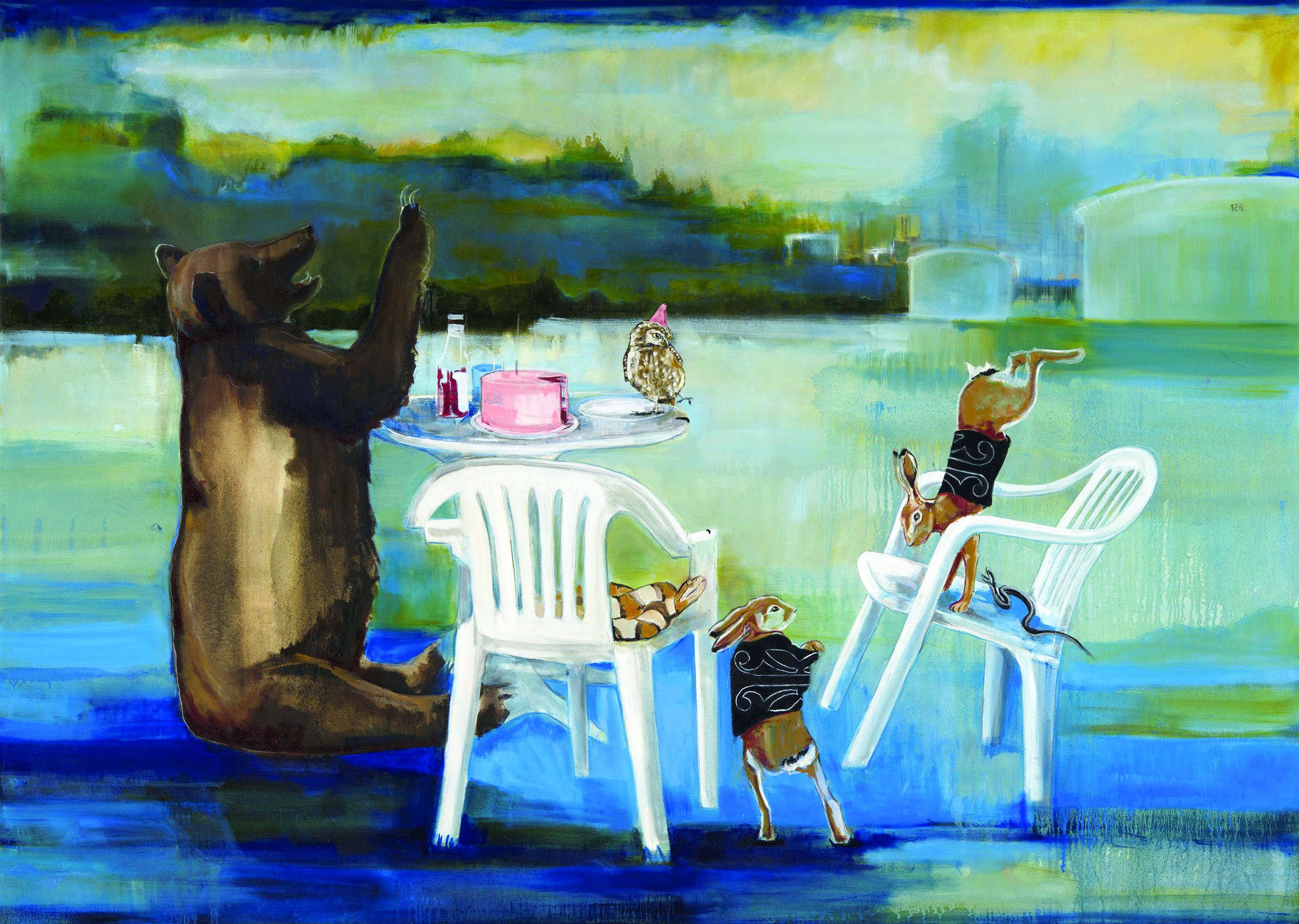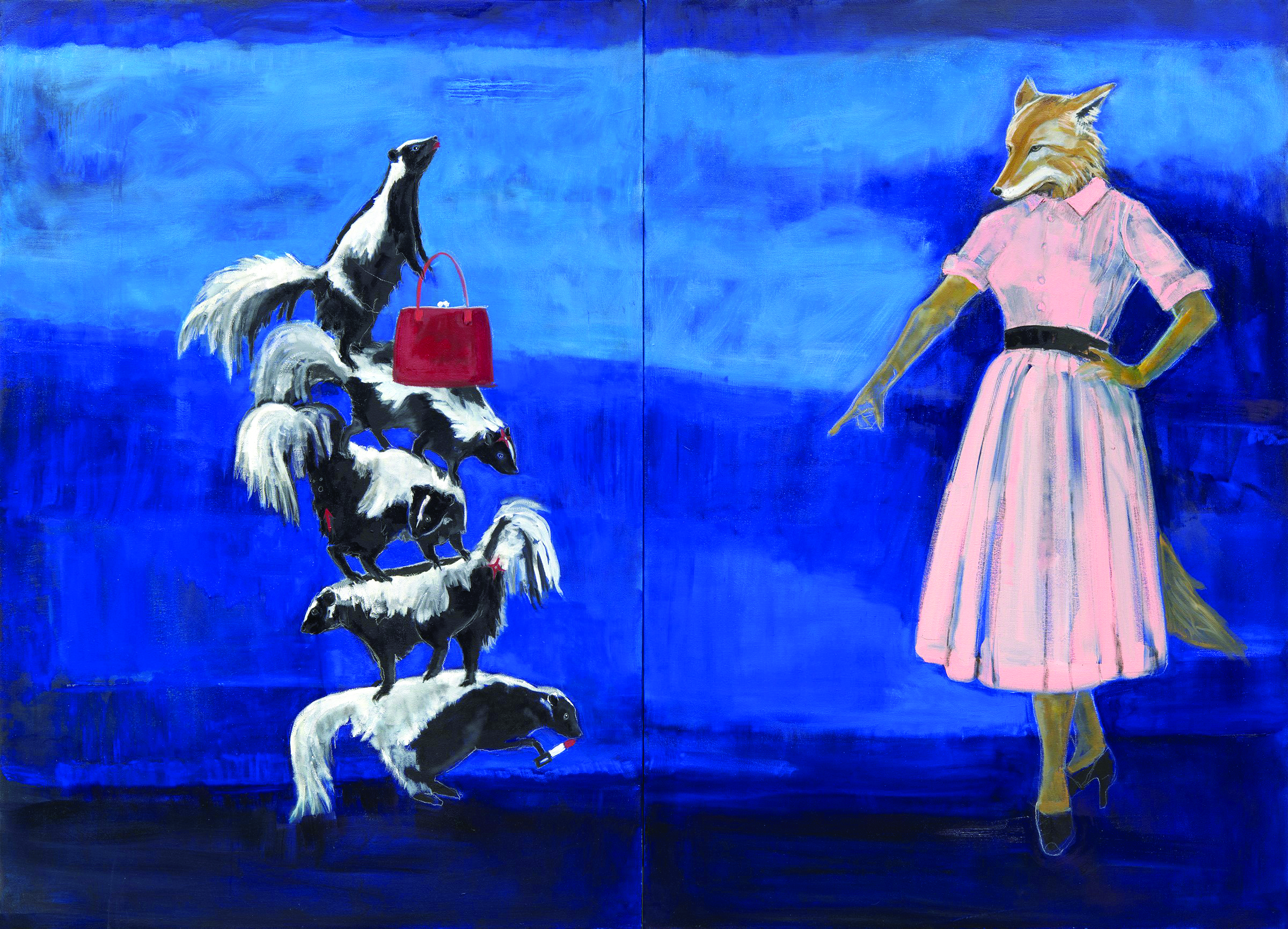
For thousands of years, humans have passed stories down to younger generations with the hope they’ll continue the practice. As a member of the Ponca tribe of Oklahoma, artist Julie Buffalohead grew up hearing the tales of her culture.
“I’m interested in all the philosophy and the things that go behind these stories. I use them as a guide and way to tell my own story,” she says. “Every person who inherits the story changes it. So you end up with very different stories than when you began, but you still maintain something about the worldview that remains the same. I feel like I’m a storyteller in a way, but maybe not exactly the same.”
Instead of relaying ideas verbally, Buffalohead continues the tradition on canvas. Her work is now on display at the Denver Art Museum in Eyes On: Julie Buffalohead, showing through April 21.
In the exhibit, Buffalohead digs into her Ponca heritage. Each of the paintings is based on the clans inside her tribe, including Hisada (the Straight Leg clan) and Ma Kan (the Medicine clan). Her work features symbols, patterns and animals associated with the different clans, but while they serve as inspiration, the paintings are only loose interpretations.
“This exhibition, it’s not a direct one-to-one correlation like, ‘Oh, this clan believes this thing or that,’” says the show’s co-curator, John Lukavic. “It’s Julie’s exploration of the learning process, about exploring that side of who she is and kind of navigating the waters of how she, as a feminist, fits within these structures. There are corollaries that she raises an eyebrow at.”

Buffalohead grew up in Minneapolis, Minnesota, but she visited her Ponca relatives every summer in Oklahoma. She was never too far away from her culture, though. Her parents were both involved in the Native American studies department at the University of Minnesota, and surrounded by her parents’ students, Buffalohead grew up around members of multiple tribes.
When Buffalohead started as an artist, she set out to capture the human experience. As time went on, her work became more personal, focusing on her own experience. Many of the works exhibited at DAM stem directly from her memories of growing up.
Buffalohead’s paintings feature animals used in Native American storytelling, including foxes, owls, bears and rabbits. When she represents herself in the work, Buffalohead frequently uses a deer figure. She also likes to use a coyote figure, which is commonly known as a trickster in mythology.
When she uses the trickster archetype to represent herself, she says, it gives her freedom because tricksters can do or be whatever they want. Moreover, for Buffalohead, the character represents the mosaic of human nature.
“I’ve always been attracted to trickster characters in Native belief systems because they’re so opposite to Judeo-Christian values. Judeo-Christian tends to be about good and evil, and it talks a lot about how you do this and it’s good, or you do that and it’s bad,” she says. “And what [animals like] coyotes and rabbits, who represent tricksters, do is really in the gray. It’s about doing both those things. It’s about having characteristics that make up good and evil, and it’s OK to be a blend of both.

“So I’ve always thought [it represents] what it means to be a human being,” she continues. “That idea is always attractive to me because you don’t have be perfect in life. It’s not always about achieving or doing the right thing or becoming the right person. You’re going to screw up in life, and it’s OK to be in that gray area in life.”
This complexity translates through Buffalohead’s art. Her paintings encapsulate a story in a single frame, and they feature a cast of characters, each with a different motive. In “Straight Legs,” a coyote lounges on a bed locking eyes with a deer, and an owl perches on the deer and stares straight at the audience. There’s much to unpack with the animals’ symbolism, expressions and perceived motives. There’s a story happening, and it depends on the audience to fill in the details.
Buffalohead’s paintings display tension between the past and present, Native and colonizer, tradition and modern life, desire and societal rules, should and want. Different characters can stand in as different sides of the same coin. In “Six Pack Colonialism,” a rabbit and owl fight against the idea of European settlers and the harm they bring, while a deer figure looks on calmly.
Another example can be seen between Buffalohead’s use of the deer and the coyote. She’s a member of the Deer sub clan, but she views the coyote as a personal symbol.
This notion is explored in her paintings, says co-curator Lukavic. She considers her role as an individual and as a member of the tribe.
“When you’re talking about societies like this and structures like this, individualism is not a foundation of those societies and belief systems or protocols,” he says. “It very much is about the group projecting the rules to the people within it. And that’s different than the way society is moving today in the larger world around her. She’s just sharing with us this inner dialogue she’s having.”

This questioning continues throughout Buffalohead’s paintings, and it can be seen in her analysis of gender roles and what it means to be a woman. In “A Little Medicine and Magic,” a coyote dons a ’50s-style pink dress while a group of skunks play with her lipstick and purse.
“[Buffalohead is] wondering, ‘What does it mean to be an indigenous feminist?’” Lukavic says. “Because you can be a feminist in larger mainstream society, but what does it mean to be an indigenous feminist within your own community? There is no answer necessarily, other than whatever you individually decide to do.”
Buffalohead puts her inquiry on the canvas. While she works in the context of her own culture, her questions supersede boundaries, making her work relatable to anyone who’s felt societal pressure or struggled with identity issues. Should one push against society or bend to its will?
“What I struggle a lot with as a woman is there’s this expectation that you have to be this sort of sexualized being, but you don’t always feel like you want to be that,” she says. “Or you get disgusted by the fact that we make this such a huge issue that women alter their bodies and do disfiguring things to be something important. I go through that too. I spent my whole life doubting who I was and questioning all these issues.”
Whatever the topic, the main objective, for Buffalohead, is authenticity. It’s visible in her choice to not offer definitive answers.
“I’m not sure if I’ve worked that out for myself — what I think,” Buffalohead says. “Maybe I haven’t really answered the questions. I’m just posing them in some way.”
Just like those who came before her, Buffalohead is passing down stories, leaving her impression on each. She may not have answers, but she’s keeping the conversation going for the next generation.
ON THE BILL: ‘Eyes On: Julie Buffalohead.’ Denver Art Museum, 100 W. 14th Ave. Parkway, Denver. Through April 21.














